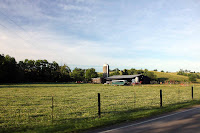Day 13: The First and Second Battles of Manassas
Wednesday, June 13 was spent at the site of the First and Second Battles of Manassas.
The First Battle of Manassas, known as the Battle of Bull Run in the North, was the first major conflict of the Civil War. What the Federals and Confederates lacked in experience, they made up in bravado. As the armies began to amassed in Virginia on July 16, 1861, both believed the "war" would be over with the first battle. On July 21, with the nation still romanticizing the idea of war as a Sunday afternoon live drama, civilians came from Washington, DC with picnic baskets to watch the events unfold. However, when the black smoke of the gunpowder faded, there were nearly 5,000 dead and wounded, including the first civilian casualty, Judith Henry, an elderly and infirmed widow, whose farm, Henry Hill, was the scene of much of the fighting.
The batle was a Confederate victory, and the beginning of the worst conflict ever on US soil. The small town of Manassas began to rebuild, and when summer returned in 1862, so did the war and the second battle of Manassas.
We started the day at the Visitor's Center, with some interesting exhibits,an electronic battlemap and a terrific 45 minute film that gave a lot of information on both battles. We walked the grounds of Henry Hill, which included the restored home of Judith Hill, and the small family cemetery where she is buried. The landscape on and around Henry Hill remains as it was in 1861and 1862 when life was interrupted not only by the battles, but the aftermath as well.
Unlike Shiloh and Vicksburg, the Manassas National Battlefield, specifically the site of Second Manassas, is not a monument park. It is a driving tour in the specific sense, in that you drive from one key location of the battle to the next. There are historical markers, but the site also includes stops at the Brawner Farm, the Stone House, Sudley Church, the unfinished railroad and the Confederate Cemetery.
The driving tour, unlike the monument tour, gives you great insight into the expanse of real estate in the town that was occupied with soldiers, tents and artillery....twice.
Read More
The First Battle of Manassas, known as the Battle of Bull Run in the North, was the first major conflict of the Civil War. What the Federals and Confederates lacked in experience, they made up in bravado. As the armies began to amassed in Virginia on July 16, 1861, both believed the "war" would be over with the first battle. On July 21, with the nation still romanticizing the idea of war as a Sunday afternoon live drama, civilians came from Washington, DC with picnic baskets to watch the events unfold. However, when the black smoke of the gunpowder faded, there were nearly 5,000 dead and wounded, including the first civilian casualty, Judith Henry, an elderly and infirmed widow, whose farm, Henry Hill, was the scene of much of the fighting.
The batle was a Confederate victory, and the beginning of the worst conflict ever on US soil. The small town of Manassas began to rebuild, and when summer returned in 1862, so did the war and the second battle of Manassas.
We started the day at the Visitor's Center, with some interesting exhibits,an electronic battlemap and a terrific 45 minute film that gave a lot of information on both battles. We walked the grounds of Henry Hill, which included the restored home of Judith Hill, and the small family cemetery where she is buried. The landscape on and around Henry Hill remains as it was in 1861and 1862 when life was interrupted not only by the battles, but the aftermath as well.
Unlike Shiloh and Vicksburg, the Manassas National Battlefield, specifically the site of Second Manassas, is not a monument park. It is a driving tour in the specific sense, in that you drive from one key location of the battle to the next. There are historical markers, but the site also includes stops at the Brawner Farm, the Stone House, Sudley Church, the unfinished railroad and the Confederate Cemetery.
The driving tour, unlike the monument tour, gives you great insight into the expanse of real estate in the town that was occupied with soldiers, tents and artillery....twice.

























